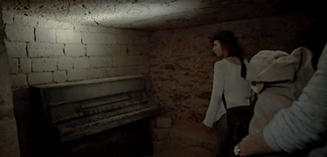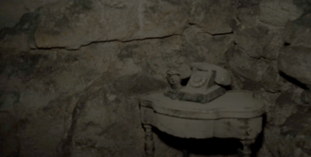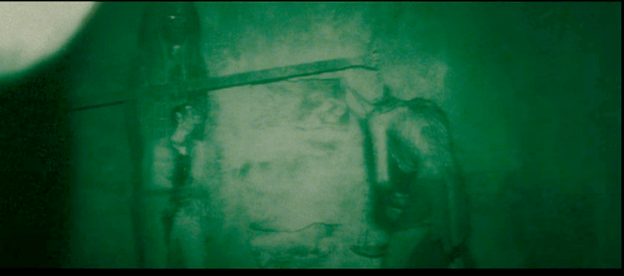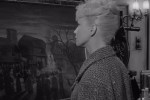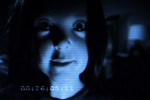Kari Sawden
At the end of the first official trailer for the 2014 found footage horror movie As Above, So Below (AASB) the audience is invited to journey into the Paris Catacombs to “discover the truth” (Rotten Tomatoes Trailers). This statement, paired with the frightening images teased in the trailer, implies that there is something more to know, and it can only be discerned through the experience of witnessing this story, pieced together from amateur footage shot by the characters. While the horror genre is no stranger to truth claims–think of all the ones “based on a true story”–the integration of documentary-style recordings adds a new layer of complexity to the reality of the narrative. Consequently, a new system of understanding is created as the audience is granted an opportunity to discover hidden truths about their world and themselves through a blending of institutional and experiential knowledge. Furthermore, while these films use new technology, they build upon much older narrative traditions, including the legend, that employ a framework of factuality to explore deeper truths.
In the films AASB and The Pyramid (2014), which will be the focus of this paper, this play with knowledge is at the forefront of each storyline as both are framed around academic quests for the truth. In the former, a team led by Scarlett Marlowe, a scholar following in her father’s footsteps in seeking the legendary philosopher’s stone, which could offer up the key to immortality, enters into the Paris Catacombs to find this artifact. Once there, however, they end up descending into a horrific journey that echoes the hell of Dante’s Inferno. In the latter film, a father-daughter team of archaeologists, Miles and Nora Holden, is in the process of uncovering an architecturally-unique pyramid, only to find themselves, once inside, being hunted by the literal god Anubis. The truth is that it is not a tomb but a prison to protect the world from a killer deity. When considering the knowledge systems of both of these movies, it is worth paying attention to the processes by which the initial ones are challenged and deconstructed by what the characters encounter, and how this results in a final approach that is an amalgamation of personal experience and institutional knowledge.
In order to understand how these systems of knowing are being constructed, and how truth is derived from or in spite of them, it is worth thinking about them in relation to external and internal ways of determining what is real. External systems of knowledge take place outside of the self. In these films, they come from the structures and verification of the academic institution, further affirmed through the documentary-style lens. This scholarly framework upon which the stories begin will be called into question as they progress. There are also internal systems of knowing that reflect our individual experiences navigating the world and making sense of it. These are often affirmed through our feelings and beliefs and can run counter to what external methods have determined to be true; however, this is not a necessity and, furthermore, does not invalidate either one. They are different ways of knowing that guide behaviour.
From early on, the stability of any single knowledge system in these films is undermined. Scarlett’s quest for the philosopher’s stone and the desire to know the truth of it already positions her outside of academic norms. Even though she is well-credentialed, this is still fringe knowledge, and it is noted that her father’s own search for it drove him to madness and suicide. In The Pyramid, there are tensions between Miles and Nora due to the means of discovery they are using. Nora has begun to utilize satellites in her search for the pyramid, which has attracted the documentary team, while her father decries the excessive focus on these new methods and the encroachment of eccentric theories like aliens into his field.
The intertwining of different systems of knowledge, and its challenge to the singularity of institutional certainty, is established early in AASB as Scarlett relies on her father’s personal notes and alchemical knowledge that, while acknowledged as an earlier form of science, is no longer regarded as valid by the academy. Furthermore, their guide into the catacombs, Papillon, draws upon his own personal knowledge to take them where the official tour guides can and will not. Throughout the movie, this individual experience is shown to be essential for the characters to make sense of what is happening. As they descend further into the catacombs, they find themselves confronted, and sometimes killed, by their own past failings and guilt. Scarlett encounters a ringing phone, and later the hanging body of her father: she did not answer his final call to her before he died by suicide. George, her former companion and reluctant participant in this journey, finds his childhood piano, complete with the broken key. It is the same one that he used to play with his brother, whom he could not save from drowning in a cave, the tragedy of which he is also forced to relive in these catacombs.
Individual past experience, however, cannot be fully relied upon to explain everything. For example, Papillon finds himself lost in the tunnels when they do not match his extensive pre-established knowledge from navigating them so many times before. Instead of taking refuge in the information they entered with, each character is required to rethink what they know about their world and to confront the whole of their understanding of themselves, including those aspects which they have kept hidden. To not do so is to be literally consumed or destroyed by them, such as when Papillon is pulled into a burning car, a memory from his own past made real again.
This process of building a knowledge system that will provide these characters with a chance of surviving such encounters requires not only acknowledging individual failures but institutional ones as well. Tomasz Sawczuk writes of the found footage horror film [REC] that it “implies that maintaining faith in the sources of institutional trust is no longer possible” (233). They cannot be relied upon to discern or disseminate the truth. Instead, transgression against such authority and any assumption that it is the arbiter of absolute truth is required. For Scarlett it is a constant in her pursuit of knowledge: the film opens with her sneaking into Iran to find the Rose Key which will allow for the translation of alchemical symbols. The Pyramid takes place during upheaval and revolution in Egypt; consequently, the team is ordered to leave the dig just as they uncover the pyramid. They justify one last trip to their new discovery to send in a rover to record what is inside, and then to enter into it to retrieve the equipment when it is damaged. Once they have done so, they are further cut off from outside institutions as they realize they have become trapped in a labyrinth.
Confronted with the limitations of external institutions to provide explanations and/or protection when tested by the personal experiences of those in these films, the characters are forced to adapt and create new systems of knowledge. However, it does not necessitate that they fully dismiss previous ones. As Nora explains, she does not want to throw out all past work about Egyptian history, but she does think it is time to innovate. The academic framework of proposing and testing new hypotheses remains useful, even if the means of doing so and the past conclusions about the reality of Egyptian gods and alchemy are discarded. By watching the scholars within these narratives come to accept that which has been dismissed or discarded by their field, the audience is given permission to take such alternative systems of knowledge, including their own experiences of these stories, more seriously. The amalgamation of these different methods, including institutional and personal, into a means by which the truth is finally known can be seen in the character of Scarlett, who discovers, by the end of the film, that the alchemical way of knowing, while hidden by riddles, codes, and metaphors, is true. She draws upon the alchemical belief of “[a]s above, so below. As I believe the world to be, so it is” in her own journey to finally becoming the philosopher’s stone herself, which allows her to save George’s life. In the merging of all knowledge, external and internal, she is able to become the truth that she has been seeking.
In The Pyramid, the truth of the individual experience is also intertwined with the external knowledge that, in this case, comes from academic studies into Egyptian history and mythology. Anubis’ portrayal here reflects his common anthropomorphic depiction of being jackal-headed, as well as fulfilling one of the tasks he is often documented performing: “weighing the heart of the deceased against the feather of truth” (Wilkinson 189).
However, through their experiences in the pyramid they come to understand that the truth of Anubis is that he is not content to wait until death to weigh a heart but will rip it out of the living. His true story is that his own past crimes have separated him from his father, Osiris, and only when he has found a pure heart can he pass into the afterlife and join him.
The stories of alchemical knowledge and Egyptian gods are revealed throughout these films to be real; however, the acknowledgement of narratives such as myths also opens up new opportunities to consider that different truths are being presented in these films that exist outside of facts, while utilizing a factual framework in order to provide the audience access to them. Of particular note are the parallels to the folk narrative genre of legend. For our purposes, they can be regarded as episodic, often short, narratives focused on the uncanny or out-of-the-ordinary (Oring 125). They are presented as true, or possibly true; although, as the folklorist Elliott Oring notes, “[t]he narration of a legend is, in a sense, the negotiation of the truth of these episodes” (125). In this way, we can see the pattern repeated in found footage horror which allows the audience to witness an uncanny event presented as real through documentary-style recordings. Like legends, which may declare that it happened to a friend of a friend or name a specific, known place where the events occurred, found footage records the reality of our world, thereby making the story more believable and giving it the feeling of truth backed up by filmed evidence.
This pattern is found in The Pyramid where its opening scenes of Cairo, Egypt establish a sense of reality. This story is set during a period of actual protest and revolution in the country. This framing is paralleled in how AASB was filmed in the Paris Catacombs (Epstein). This “interpenetration of reality and fiction” (Sayad 43) opens up enticing possibilities that the story could really be true. This potential is further enhanced by the expectation that “the images must look rawer and less edited than those of a mainstream film” (Reyes 129). In much the same way that an imperfect story told amongst friends has a sense of immediacy and believability in a way that a polished version may not, the imperfection of the footage heightens its claims of factuality.
This sense of reality is not, however, the only form of truth that legends, and horror, delve into. While on the surface it appears that it is about external, recognizable facts, the folklorist Bill Ellis writes that “a legend is like a name, or word, in that it expresses, or ‘tells’ the anxiety specific to a particular place and time. Legends are part of a cultural ‘belief-language’ that helps individuals make sense of disorienting and stressful experiences” (4). Echoing this, Cecilia Sayad, a scholar of film, writes of horror and science fiction that they serve “as allegories of social and historical anxieties” (49) and how this “tackling of domestic problems imbued the horror film with a more direct form of social commentary, expressed through an appropriately realist aesthetics defined by real locations, handheld camera, and grainy cinematography” (50). The systems of knowledge here guide the individuals to truths that do not always align with facts but still speak to real fears and social anxieties.
To engage with the truth of these films you do not need to believe that what you have witnessed is a documentary. Perhaps the Paris Catacombs will not lead you into hell, but grappling with and being consumed by the guilt of past mistakes and the hurt you have caused to others is its own form of damnation. Maybe there is no god being held prisoner in a buried pyramid, but the fear of watching those you love suffer and die while you remain helpless is very real. In these films, the truths we are asked to encounter and learn are not just about the reality of alchemy, hell, or Egyptian gods but about the normal experiences and questions we struggle with: What are we haunted by? What weight do our hearts bear? What exists beyond or after this life?
While found footage horror purports to show the “real truth” of what happened to its characters through direct documentation, it also encourages the challenging of any singular way of knowing and, instead, asks for a collaborative process of truth-seeking that involves institutional knowledge, both past and present; the personal histories we bring with us; and what we learn from our experiences in the moment. No single approach is enough. Instead, we need it all and the flexibility to be open to whatever may occur. And we must be willing to look beyond the facts to find different truths about the fears and anxieties of our world that drive us towards these stories.
Works Cited
Aldana Reyes, Xavier. “Reel Evil: A Critical Reassessment of Found Footage Horror.” Gothic Studies, vol. 17, no. 2, 2015, pp. 122-136. DOI:10.7227/GS.17.2.8.
As Above, So Below. Directed by John Erick Dowdle. Universal Pictures and Legendary Entertainment, 2014.
Ellis, Bill. Raising the Devil: Satanism, New Religions, and the Media. University Press of Kentucky, 2000.
Epstein, Annie. “Filming in the Paris Catacombs for As Above, So Below.” Motion Picture Association, 13 Aug. 2014.
Oring, Elliott. “Folk Narratives.” Folk Groups and Folklore Genres: An Introduction, edited by Elliott Oring, Utah State University Press, 1986, pp. 121-145.
The Pyramid. Directed by Grégory Levasseur. 20th Century Fox, 2014.
Rotten Tomatoes Trailers. “As Above, So Below Official Trailer #1 (2014).” YouTube, 25 Apr.
Sawczuk, Tomasz. “Taking Horror as You Find It: From Found Manuscripts to Found Footage Aesthetics.” Text Matters, no. 10, 2020, pp. 223-235. DOI:10.18778/2083-2931.10.14.
Sayad, Cecilia. “Found-Footage Horror and the Frame’s Undoing.” Cinema Journal, vol. 55, no. 2, 2016, pp. 43-66. DOI: 10.1353/cj.2016.0003.
Wilkinson, Richard H. The Complete Gods and Goddesses of Ancient Egypt. Thames & Hudson, 2017.

